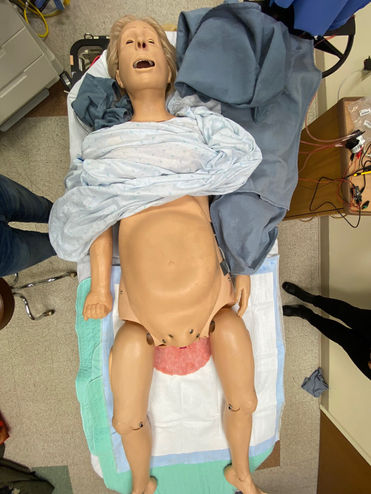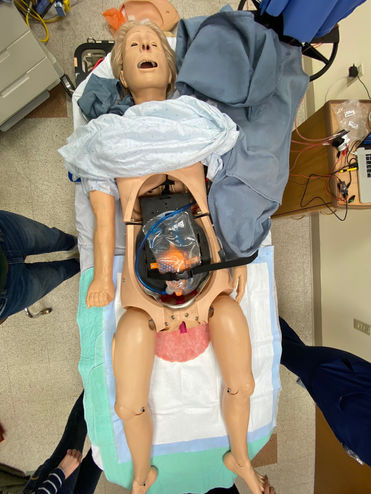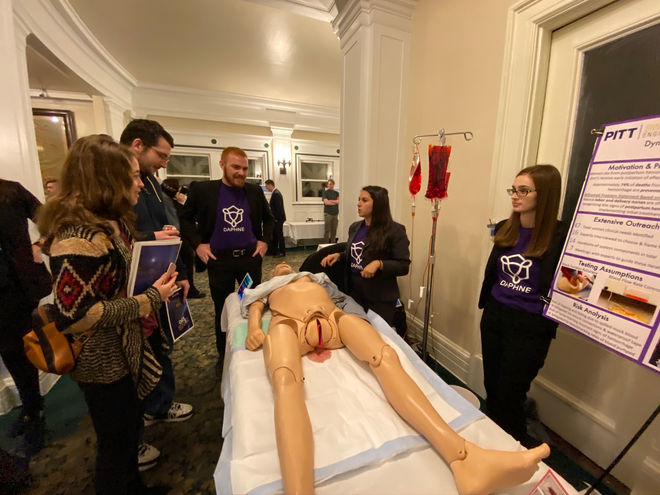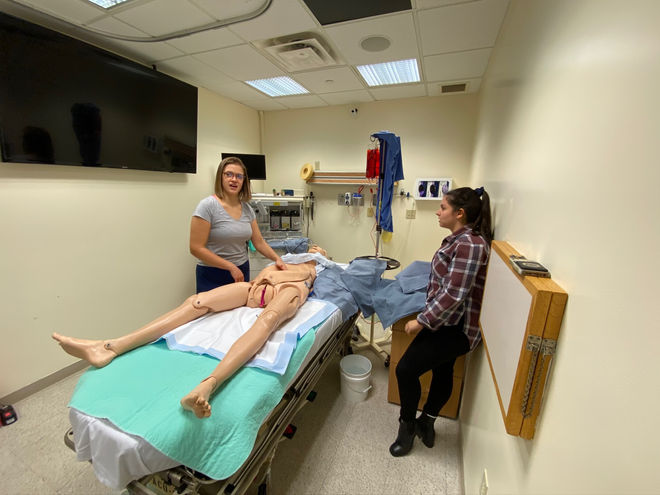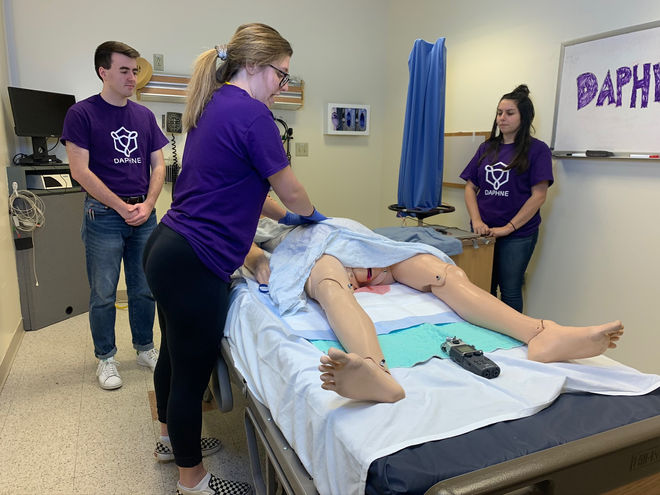
The leading cause of maternal mortality in our country is postpartum hemorrhage, which is excessive maternal bleeding within the first 24 hours after birth. Despite this, approximately 74% of these deaths are preventable. Women die from postpartum hemorrhage because they fail to receive early initiation of effective intervention.
Based on conversations with simulation centers at Pitt, Harvard, Penn State, and Ohio State, we found that existing labor and delivery simulators are insufficient to fully train nurses to properly manage postpartum hemorrhage.

In affiliation with:


DAPHNE aims to help novice labor and delivery nurses better recognize and initially manage postpartum hemorrhage via simulation
Documentation created for this design
-
Comprehensive Design History File
-
In accordance with FDA Quality System Regulation 20 CFR 820.30
-
-
Ethnography Plans
-
User Needs and Intended Uses
-
Product Design Specifications
-
Risk Analyses
-
Initial Hazards Analysis
-
Risk Summary
-
Failure Mode Effect Analysis
-
Fault Tree Analysis
-
-
Traceability Matrix
-
Verification Protocols and Test Reports
-
Validation Protocols and Test Reports
My personal contributions
-
Conducted approximately 25 User and Expert Interviews
-
Documented Product Design Specifications
-
Drafted Risk Analyses
-
Created prototype iteration 1 and 2
-
Designed and built uterus system
-
Conducted 4 usability tests involving the uterus system
-
Collaborated on uterus system-base integration
-
Created Validation Plan
-
Filed for IRB approval
-
Drafted Design Expo Pitch
-
Assisted in forming a comprehension Design History File
-
Designed and casted silicone mold stomach
-
Wrote VAL-1 and VAL-3
Prototypes





Uterus System Objective:
We want to create a dynamic uterus that can transition from soft to firm upon abdominal massage
When nurse initiates a proper fundal massage, the simulation operator controls the dynamic uterus inside DAPHNE to contract via deflation of a water-filled pouch connected to a solenoid-operated valve. Upon deflation, the nurse can feel the anatomically accurate firmer and smaller 3D printed uterus.
.jpeg)
 Iterative design of 3D-printed uterus |  Iterative design of base |  Water reservoir and electronic solenoid valve |
|---|---|---|
 Uterus model and water bladder strapped to base via nylon straps. Base secures uterus at varying locations in relation to the umbilicus |  Iteration of uterus system |  L&D Nurse Abby Slocum performing fundal massage and giving feedback on the fidelity of the uterus system |
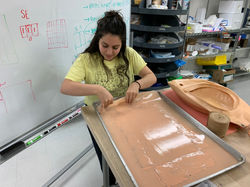 Creating thinner and more malleable stomach via silicon molding based on user feedback | 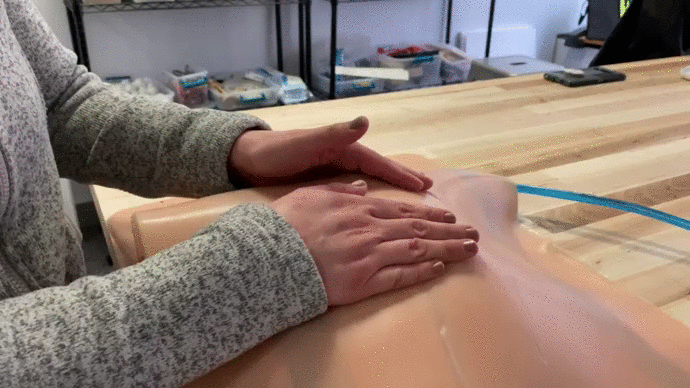 L&D Nurse Abby Slocum performing fundal massage on stomach prototype and uterus system |  Uterus system integrated into labor and delivery mannequin |
 Uterus system integrated into labor and delivery mannequin |  Dr. Sakamoto, Professor of Department of Obstetrics, Gynecology and Reproductive Science, giving feedback |
"When I was really new to obstetrics, I was not sure if it was boggy or if I was just doing it wrong..."
-Abby, L&D Nurse at Magee Women's Hospital
Blood System Objective:
We want to simulate blood loss at a physiologically accurate and controllable rate, which nurses can quantify during the scenario.
Simulation operator modulates blood flow based on the scenario and in response to fundal massage. Mock blood flows with a peristaltic pump up to 100 mL/min via microcontroller adjustment.
.jpeg)
 Testing flow rate of blood pumps |  Different shades of mock blood |  Blood system inside labor and delivery mannequin |
|---|
Current Model

"I've never seen anything like this in a simulation"
-Senior Nursing Student at Pitt
Verification and Validation
VER-1: Mock Blood Flow System Controlled Flow
This test will measure the flow rate of liquid exiting the system to ensure it is flowing at a physiologically accurate rate for postpartum hemorrhage.
During the mock blood flow rates testing an average of 108.59 mL/min was reported over the 10 min testing period. This test confirms that our system of peristaltic pumps is sufficient in pumping the blood at a physiologically accurate rate for the duration of the time the participant will be interacting with the simulation.
VER-2: Mock Uterus System Water Evacuation
This test will measure the ability of water to exit the water bladder simulating a physiologically accurate contracting uterus during a fundal massage.
The results show that the average water evacuation of the uterus due to 50 lbs of simulated fundal massage pressure over 30 seconds is 1097.4 L. The average volume of water released was below the original acceptability criteria of a minimum of 1200 mL

VER-3: Mock Uterus System Compressive Force
This test will measure the ability of the system to withstand a continuous compressive downward force while simulating a “boggy” fundus (inflated water reservoir) and a “firm” fundus (deflated water reservoir).
The results show that the mock uterus system is robust enough to withstand a compression of a 850 N load.

VER-4: Mock Uterus System Cycle Testing
This test will measure the ability of the system to withstand a continuous compressive downward force while simulating a “boggy” fundus (inflated water reservoir) and a “firm” fundus (deflated water reservoir).
The results show that the mock uterus system is robust enough to withstand repeated 45 second compressions of a 530 N load
VAL-1: Performance Validation Test
This test will evaluate whether the simulation trainer meets the learning needs of participant novice labor and delivery nurses with respect to postpartum hemorrhage events using a before and after design. The hypothesis of the study is whether deliberate practice of an obstetric postpartum hemorrhage scenario incorporating DAPHNE (realistic fundus and blood loss system) improves participant performance in postpartum hemorrhage recognition and initial management.

Due to the extenuating circumstances during Spring 2020 of the coronavirus pandemic, VAL-1 was unable to be executed as planned. WISER IRB approval was obtained and six School of Nursing participants with L&D experience were recruited and scheduled to execute
VAL-1 protocol the weeks of 3/16 and 3/23. However, to maintain proper social distancing guidelines emphasized for Allegheny county the study was canceled.
VAL-2: Anatomical Fidelity Validation Test
This test will evaluate whether the mock uterus component enables the simulation of a fundal massage with appropriate anatomical fidelity. The goal is to determine the similarity of the mock dynamic uterus to real life experience.
Due to the extenuating circumstances during Spring 2020 of the coronavirus pandemic, VAL-2 was unable to be executed as planned. Only one of the subject matter experts was able to evaluate the fidelity of the device the week of 3/2. However, to maintain proper social distancing guidelines emphasized for Allegheny county the study was canceled.
VAL-3: Video Validation Test
This test will collect feedback from simulation operation specialist and novice nursing students (at least one rotation of labor and delivery unit experience) on the importance and effectiveness of the device components (mock blood loss system, dynamic uterus system, and physiologically accurate skin) for a postpartum hemorrhage simulation training. The goal is to collect feedback on the functionality and usability of the device. In terms of acceptability criteria, participants surveyed should on average indicate that the device is at minimum satisfactory representation, defined as an average of 3.5 out of 5 or greater on the survey questions. The scoring of survey questions is as follows: 1-strongly disagree, 2-disagree, 3-neutral, 4-agree, 5-strongly agree.
Results
The Simulation Specialist survey received six responses from institutions like SimTiki Simulation Center in Honolulu, Hawaii, Sidra Medicine in Doha, Qatar, Penn State Health Milton S. Hershey Medical Center in State College, Pennsylvania, The Ohio State University Wexner Medical Center in Columbus, Ohio, Mark Richardson Interprofessional Simulation Center in Portland, Oregon, and the Jackson Memorial Hospital Center for Patient Safety in Miami, Florida. The Nursing Student survey received seven responses from either junior or senior nursing students at the University of Pittsburgh School of Nursing. The components of the DAPHNE system were surveyed by simulation specialists to have a mean importance of 4.22 and an overall mean effectiveness of 3.89, and the components of the DAPHNE system were surveyed by nursing students to have an overall mean importance of 3.78 and a mean effectiveness of 3.86.
Future Direction
We hope to improve our current design and continue the efforts of VAL-1 with the addition of new nursing and engineering team members in the Fall as a Classroom to Community project. We hope that DAPHNE will one day be available to simulation centers and nursing schools everywhere!

Received first place in the Bioengineering category at the Swanson School of Engineering Design Expo Fall 2019
Thank you to my incredible team members, Maddie Hobbs, Jake Meadows, Tyler Bray, Ally McDonald, Jessica Brown, and our mentor Dr. Joseph Samosky for making this project possible. Thank you to WISER, Dr. Sara Sakamoto, Dr. John O'Donnell, Abby Slocum, and Tom Dongilli for their advice and support on this project.



